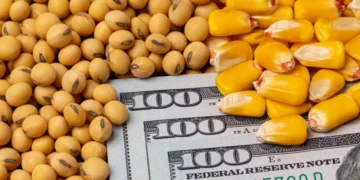Analysts Predict Upward Trend as Soybean-to-Corn Price Ratio Signals Market Reversal
The global soybean market is exhibiting signs of a significant price upswing, driven by a combination of historical price ratios, shifting crop patterns in Ukraine, and evolving global demand dynamics.
Market Indicators Suggest Imminent Price Surge
Analysts from PUSK, the analytical department of the All-Ukrainian Agrarian Council (UAC), have highlighted a notable drop in the soybean-to-corn price ratio to 2.0–2.2. Historically, such a ratio has been a precursor to a bullish trend in soybean prices. Current observations from the U.S. futures market corroborate this potential trend reversal, indicating that soybean prices may begin to rise in the short term.
Ukraine’s Crop Shifts Impact Global Supply
In Ukraine, a strategic shift in crop planting is underway, with farmers reducing soybean acreage in favor of corn. This change is expected to exacerbate the supply imbalance in the near future, potentially leading to a significant increase in soybean prices over the next one to two seasons.
Despite a record soybean production of 7.0 million metric tons in the 2024/25 marketing year—up 35% from the previous year—Ukraine’s soybean stocks as of February 1 were estimated at 3.4 million tons, significantly higher than the previous season’s 2.6–2.7 million tons. However, the reduction in soybean planting areas may offset this surplus, tightening global supply.
Domestic Market Dynamics Favor Processing Over Export
Within Ukraine, market participants are increasingly directing sales towards processing channels with higher liquidity. Procurement prices at processing plants currently range between 17,700–18,000 UAH per ton for small batches, offering more profitability compared to exports through ports, where prices have declined. Nevertheless, experts anticipate that by the end of May, soybean prices at ports will again exceed $400 per ton.
Strengthening Prices Amid Demand: Insights from APK-Inform
APK-Inform reported on May 12, 2025, that strong domestic demand in Ukraine has led to a slight increase in purchase prices, with averages now between 17,300 and 17,500 UAH per ton CPT. Meanwhile, minor adjustments were observed at Ukrainian ports, where prices moved within a 2–3 USD per ton range.
Current demand prices at ports hover between 392 and 395 USD per ton CPT, occasionally dipping to 390 USD. However, despite these developments, trading activity is seasonally slowing, and demand/offer prices for key export markets are gradually decreasing.
For instance, offer prices for deliveries to Turkey (May-June) have eased to around 420 USD per ton CIF, compared to 422–425 USD last week, reflecting a cautious yet persistent demand trend.
Global Factors Contributing to Price Volatility
Global soybean supply is facing additional pressures. In Brazil, harvesting delays due to high soybean moisture have led to significant field losses, potentially altering global balances and supporting prices. Moreover, geopolitical tensions and trade dynamics, such as China’s tariffs on U.S. soybeans, are influencing global demand patterns, with buyers turning towards Ukrainian and Brazilian suppliers.
Outlook
Considering the historical price ratios, crop planting shifts in Ukraine, and global supply challenges, the soybean market is poised for a significant price increase in the near future. Market participants and stakeholders should closely monitor these developments to navigate the evolving landscape effectively.
Major Export Perspectives:
- Export Values: Ukrainian soybean exports are anticipated to exceed $400 per ton by the end of May.
- Exporters: Ukraine, Brazil, United States
- Importer Countries: China, European Union, India
Top Competitor Producer: Brazil remains a leading competitor in soybean production, with significant exports to global markets.
Key Importers: China, European Union, India
Latest Import/Export Statistics: As of February 2025, Ukraine’s soybean stocks were estimated at 3.4 million tons, with exports showing signs of increased activity towards processing channels due to more favorable pricing compared to port exports.












